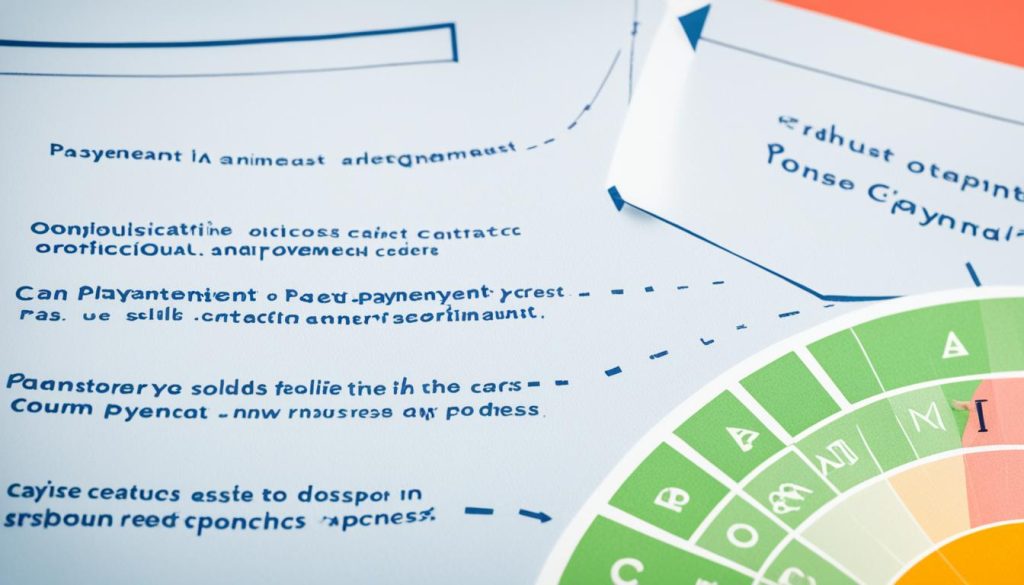Contracts are crucial in business. They lay the groundwork for agreements and pave the way for collaboration. But why are clear contracts and agreements so vital? Are they just legal papers, or is there more to it?
This guide delves into why clear contracts and agreements are key. We’ll look at what makes them strong. This includes the role of clear communication and how to review contracts. We aim to show how to make contracts that build trust and ensure success. So, let’s get into the details of making clear, solid agreements.
Key Takeaways:
- Clear contracts and agreements offer more than legality. They bring trust and clarity to business deals.
- Strong contracts set boundaries, expectations, and promises. This helps avoid misunderstandings and lowers risks.
- Creating a good contract involves using clear language, defining terms well, and addressing possible problems.
- Reviewing contracts makes sure they comply with laws, can be enforced, and can adapt to unexpected events.
- Contracts that are well-made and reviewed provide clarity, legal safety, and risk reduction.
The Significance of Solid Contracts
Solid contracts are vital in business. They serve as links between what we want to do and actually doing it. They are more than just legal papers. They build trust and make things clear in business deals.
These contracts set boundaries and expectations. They make sure everyone knows their job. This understanding stops confusion and problems before they start.
Solid contracts help avoid misunderstandings. They make sure everyone agrees from the start. With clear terms, the risk of disagreements drops.
They lay out what we expect from each other. They include deadlines and what we need to do. This makes for a stronger team effort.
“Clear communication is key when it comes to contract agreements. By defining terms clearly, everyone can avoid trouble and keep their promises.” – Kate Johnson, Legal Expert
Solid contracts also protect everyone involved. They spell out everyone’s rights and duties. This prevents problems and ensures fair pay for work done.
These contracts ensure fairness. They also build trust and respect in business. This is crucial for professional relationships.
The best contracts are clear and thorough. The stronger the contract, the less chance of issues. Focusing on clear agreements is key for good business relationships.
Key Elements of Contract Drafting
Creating a solid contract requires focusing on several crucial elements. These elements make sure the contract is legally valid. They also clarify everything for everyone involved and build a foundation for a smooth agreement.
Clear Language and Absence of Ambiguity
Using clear and precise language is vital in contract drafting. It removes any chance for misunderstanding. This way, everyone knows exactly what the agreement means.
Thoroughly Defined Terms
To prevent confusion, it’s important to define all terms in the contract. Clearly explained terms help everyone understand their duties and rights.
Obligations of Each Party
A good contract lays out what each party has to do. It mentions specific actions or services expected. This sets a clear path for everyone to follow.
Addressing Potential Issues
It’s smart to think ahead about possible problems in contract drafting. Including plans for unexpected events can reduce risks. It also creates a way to solve disagreements if they happen.
“In contract drafting, the devil is in the details. By thoroughly considering the potential pitfalls and incorporating provisions to address them, you can avoid unnecessary conflicts and ensure a smoother agreement execution.” – Sarah Johnson, Contract Law Expert.
Specificity and Detail
Being specific is key when drafting a contract. It avoids misunderstandings. Adding details like timelines and payment terms sets clear expectations and helps avoid disagreements.
Visual Representation of Key Elements
To see the main points of contract drafting visually, look at the table below:
| Key Element | Description |
|---|---|
| Clear Language and Absence of Ambiguity | Using language that leaves no room for interpretation or misunderstanding. |
| Thoroughly Defined Terms | Including precise definitions of key terms and concepts specific to the agreement. |
| Obligations of Each Party | Clearly outlining the responsibilities and actions expected from each party. |
| Addressing Potential Issues | Incorporating provisions to handle unforeseen circumstances or disputes. |
| Specificity and Detail | Including precise details about timelines, deliverables, payment terms, etc. |
Paying close attention to these elements makes your contracts clear and detailed. This ensures a successful agreement.
The Art of Contract Review
Reviewing a contract is key to making sure it meets legal standards and catches any unclear parts. It helps make sure the contract works well, sticks to the rules, and avoids problems. We’re going to look at why reviewing contracts matters for good negotiations and following rules.
Identifying and Addressing Deviations
It’s crucial to find and fix any parts of a contract that might not go as planned. Including special clauses helps keep the contract strong, even when things change. This way, we can avoid disagreements later.
Ensuring Compliance with Legal Requirements
Checking a contract’s legal standing is a main goal. Legal experts look for any parts that might break the law. Finding and fixing these parts helps everyone involved and reduces legal trouble. This makes the contract more solid and legally sound.
“The careful review of contracts allows parties to identify any potential risks, ensure compliance, and promote contract enforceability.”
Identifying and Eliminating Ambiguities
Part of reviewing contracts is making sure there’s no confusing language. Clearing up any confusion makes the contract clearer. This lowers the chance of disagreements, keeping everyone on the same page.
Promoting Contract Adaptability
Contracts need to be flexible to handle changes that come up. Reviewing helps find where changes might be needed. Adding flexibility lets everyone deal with surprises without big hassles or fights.
Summary
Reviewing contracts is crucial for making good agreements and following rules. Paying attention to detail, fixing potential issues, checking for legality, removing unclear parts, and allowing for changes make contracts work better. These steps help safeguard interests and support successful business ventures.
Stay tuned for more on the importance of drafting and reviewing contracts carefully.
Benefits of Solid Contract Drafting and Review
When it comes to business contracts, being clear and open is key. A well-made and deeply checked contract brings many benefits. It helps businesses succeed.
Transparent Terms
Solid contract creating and checking sets up clear terms. By spelling out each party’s duties, contracts build mutual understanding. Clear terms cut confusion. This helps everyone agree and stops future problems.
“Transparency is the key to building trust and maintaining open communication in business relationships.”
Clarity and Understanding
Diligently made and checked contracts add to clear understanding. They use clear and direct language. This leaves little room for wrong interpretations and lessens confusion.
When language is clear, everyone knows their rights and duties. This makes business relationships smoother and more successful.
Legal Protection
Good contract writing and checking also protect legally. Great contracts have clauses that defend everyone’s interests. They outline what to do if there’s a problem. This legal base can solve fights, maybe without going to court.
Risk Mitigation
Good contract work identifies and tackles possible risks. A deep review makes sure all risks are thought about. Contracts have plans for these risks. This way, businesses can lower bad effects on their work and money.
Properly Identifying Parties
Making a contract means being very careful from the start. You must correctly identify everyone involved. This means using the actual legal names of people and companies. If you get the names wrong, it could cause big problems later.
When you write a contract, always use the full legal names of people. This keeps things clear and prevents confusion. Also, if companies are part of the deal, use their official names, not short forms or nicknames.
Getting names right in a contract is key for good communication. It makes everyone’s duties and rights clear. This helps enforce the agreement and solve any problems if they come up.
“The legal names of the parties are the pillars of a contract. They carry the weight of the contractual binding agreement, ensuring that responsibilities and legal rights are firmly established.”
Legal names make the contract strong and clear. If there’s a problem, the contract helps figure out how to fix it.
Being precise with names in a contract is very important. It doesn’t matter if it’s a person or a company. Using legal names builds trust and makes the contract strong.
Including All Details
Creating a solid, trustworthy contract requires attention to every detail. This includes all specific requirements for every party involved. A detailed written contract provides a strong base for a successful agreement.
A comprehensive contract makes expectations clear to all parties. It reduces the chances of misunderstandings or unmet obligations. The contract covers work scope, deliverables, timelines, milestones, and other vital areas.
By including essential details in the contract, a clear roadmap is created. This roadmap helps avoid discrepancies and builds a trusting, collaborative relationship.
Clear Communication and Legal Protection
Every detail matters for clear communication between parties. It’s crucial to specify roles, responsibilities, and expectations. Details on payment, intellectual property, confidentiality, and dispute resolution are essential. These elements ensure a working environment that benefits everyone.
“A well-written contract provides the necessary legal protection for both parties in case of disputes or breaches of contract. It serves as a reference point that outlines the agreed-upon terms and provides a basis for resolving conflicts.”
A written contract holds all parties accountable. It safeguards the rights and interests of everyone, lowering the risk of disputes or legal issues.
Writing a contract with all specific requirements forms a strong foundation for partnership. Clear, precise agreements promote communication, trust, and effective execution.
Clearly Describing Payment Requirements
Money disagreements often lead to disputes. It’s crucial to clearly outline payment obligations. A detailed description helps avoid misunderstandings and ensures smooth financial dealings.
It’s essential to say who makes payments, whether it’s one party or both. The payment amount and the currency must be clear. Also, include payment deadlines, with specific dates or timeframes.
Remember that precision is key when describing payment requirements. Use clear and concise language, leaving no room for misinterpretation. Emphasize the importance of timely payments and highlight any consequences or penalties for late or missed payments. This will ensure that all parties involved understand their financial responsibilities and can fulfill their payment obligations without complications.
Sample Payment Requirement Layout:
| Payment Obligations | Amount | Due Date |
|---|---|---|
| Party A | $X,XXX | DD/MM/YYYY |
| Party B | $X,XXX | DD/MM/YYYY |

By clearly describing payment requirements, you set up a strong base for financial transactions and avoid disputes. Open, transparent talks about payment duties pave the way for a successful business relationship.
Communicating Instructions for Contract Termination
Contracts are legally binding agreements that outline the terms for business relationships. They should also include how to end the contract if needed before its due date. By having clear instructions for ending a contract, everyone involved can understand what to do. This helps prevent arguments and confusion.
Agreement Expiration: Contracts often have a set end date. Knowing this date is important, so everyone knows how long the contract lasts. It helps avoid confusion and lets all parties plan ahead. This way, when the contract ends, there are no surprises.
Contract Termination: Sometimes, a contract may need to end early. It’s crucial to explain how and why this can happen right in the contract. This should detail when either side can end the contract, like if someone doesn’t follow the rules or breaks the contract terms.
Facilitating a Smooth Transition: Ending a contract means making sure things go smoothly afterwards. The contract should describe how to tell the other party it’s ending, how to wrap things up, and how to handle any last responsibilities. This makes the process easier for everyone.
Clear instructions for ending a contract ensure everyone knows their rights and what to do if the contract needs to end. This keeps the process fair and open, helps avoid legal problems, and makes things go smoothly if the contract ends.
Example Contract Termination Instructions:
If one side breaks the contract terms, the other can end the contract. They need to send a written notice explaining why and when the contract will end. Any final duties must be finished within 30 days, and confidential info should be returned or destroyed as agreed.
Key Elements for Contract Termination Instructions:
| Element | Description |
|---|---|
| Agreement Expiration | The date when the contract ends on its own. |
| Contract Termination | How and why a contract can be ended early. |
| Smooth Transition | Steps and rules for a smooth change after ending a contract. |
Conclusion
Making and checking contracts is about more than just laws. It needs a careful look, smart planning, and a strong commitment to trust and being clear. By putting in the time to make detailed and complete contracts, businesses lay a strong base for success. They also build lasting relationships based on talking openly.
A great contract acts like a guide. It shows everyone what they should do, expect, and what rights they have. This paves the way for working together well. It helps everyone understand each other, which cuts down on confusion and lessens risks. Trust is key in any business link. A good contract makes people feel safe that their interests are safe.
For contracts to work well, they must be well-made from the start. They need to clearly say what each person or group has to do. By dealing with possible problems and having clear rules, contracts can be flexible and strong. Making clarity and talking openly a top priority helps businesses overcome challenges. This way, they can achieve results that work well for everyone.




